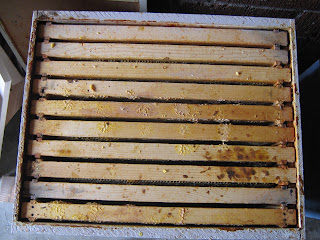The mystery of what killed the bees still remains a mystery. I have been told that cold is an unlikely cause because of the mild temps in this area. Others suggest failing queens, disease, or moisture. Moisture causes are hard to diagnose because the dilema is, what came first: mold development from the lack of ventilation or did the mold arrive after the bees died? I have moved beyond the need to solve this mystery and decided to provide better ventilation this next year and eliminate as much mold as I can to alleviate some of the workload for the bees.
Last weekend I attended a monthly bee meeting at Zenger Farm. This is a great place to meet other beekeepers in the area and learn hands-on skills with the farm's apiary. At this meeting, I bee-friended another newbie in the group. He is starting beekeeping this year and is full of questions and energy like me! His hives are used, so he blow-torched the insides to kill the mold and any possible diseases that could be lurking in the old hives. He offered me the use of his blow-torch which I was extremely grateful for!
So...here's the process: 1. empty the supers of all frames, 2. slightly scald the interior of the boxes taking extra care in the corners, and 3. sand off the black char. An optional step at the end is to spray the boxes with straight vinegar. Like everything in life, everyone has opinions. Some beekeepers I talked to never torch their hives and leave it up to nature and the bees to get rid of the mold. I try to have a biodynamic approach to beekeeping, but I also have a caring sole and want to help lessen the workload on my bees. There is plenty of mold on the frames and comb in the hives which will keep the colonies plenty busy when they enter their new home. The mold I can get rid of is on the inside of the supers/boxes. To get mold off the frames, I would litteraly have to scrape off all the comb which is a messy job and the hives are half-full of honey. I have also read several books that recommend beekeepers to scorch their hives every couple years to kill any possible diseases. I also think scorching could help seal the wood more on the inside.
Notes: The red stuff you see on the boxes is propolysis which is good stuff----very sticky stuff that bees gather from sap on trees and resins from plants to help seal all cracks in the hive. Think of it as insulation for their home.
Torching the Hives!
Posted by
Holly
on
Sunday, March 6, 2011
(Super full of frames)
(Black/gray stuff is mold)
(Scalding the inside to kill the mold)
(What the blow torch looks like)
(Sanding after the scorching)
(Finished super after the torching and sanding)
Labels: Bees










0 comments :
Post a Comment